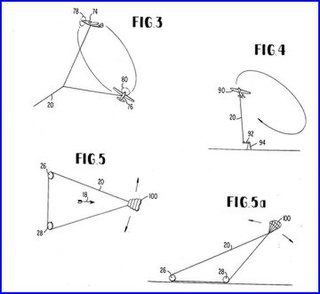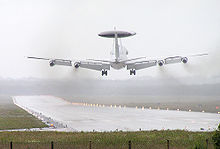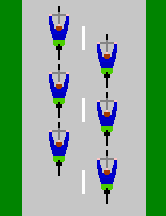
An airfield traffic pattern is a standard path followed by aircraft when taking off or landing while maintaining visual contact with the airfield.
Dynamic soaring is a flying technique used to gain energy by repeatedly crossing the boundary between air masses of different velocity. Such zones of wind gradient are generally found close to obstacles and close to the surface, so the technique is mainly of use to birds and operators of radio-controlled gliders, but glider pilots are sometimes able to soar dynamically in meteorological wind shears at higher altitudes.

In a road bicycle race, the peloton is the main group or pack of riders. Riders in a group save energy by riding close to other riders. The reduction in drag is dramatic; riding in the middle of a well-developed group, drag can be reduced by as much as 95%. Exploitation of this potential energy saving leads to complex cooperative and competitive interactions between riders and teams in race tactics. The term is also used to refer to the community of professional cyclists in general.

A slip is an aerodynamic state where an aircraft is moving somewhat sideways as well as forward relative to the oncoming airflow or relative wind. In other words, for a conventional aircraft, the nose will be pointing in the opposite direction to the bank of the wing(s). The aircraft is not in coordinated flight and therefore is flying inefficiently.
Ground speed is the horizontal component of the velocity of an aircraft relative to the Earth’s surface, also referred to as "speed over the ground". It is vital for accurate navigation that the pilot has an estimate of the ground speed that will be achieved during each leg of a flight.

Aquaplaning or hydroplaning by the tires of a road vehicle, aircraft or other wheeled vehicle occurs when a layer of water builds between the wheels of the vehicle and the road surface, leading to a loss of traction that prevents the vehicle from responding to control inputs. If it occurs to all wheels simultaneously, the vehicle becomes, in effect, an uncontrolled sled. Aquaplaning is a different phenomenon from when water on the surface of the roadway merely acts as a lubricant. Traction is diminished on wet pavement even when aquaplaning is not occurring.

The maximum takeoff weight (MTOW) or maximum gross takeoff weight (MGTOW) or maximum takeoff mass (MTOM) of an aircraft, also known as the maximum structural takeoff weight or maximum structural takeoff mass, is the maximum weight at which the pilot is allowed to attempt to take off, due to structural or other limits. The analogous term for rockets is gross lift-off mass, or GLOW. MTOW is usually specified in units of kilograms or pounds.
A tailwind is a wind that blows in the direction of travel of an object, while a headwind blows against the direction of travel. A tailwind increases the object's speed and reduces the time required to reach its destination, while a headwind has the opposite effect.
The clock code is a method of mentally computing the sine of an angle between zero and sixty degrees. Pilots sometimes need to do this to estimate the heading correction due to the wind, and sailors may find it useful to do the same thing to allow for the current due to the tides.

Marin County Airport or Gnoss Field, formerly O56, is a public airport two miles northeast of Novato, California, United States. It covers 90 acres (360,000 m2), and has one runway and one helipad.

Bicycle performance is measurable performance such as energy efficiency that affect how effective a bicycle is. Bicycles are extraordinarily efficient machines; in terms of the amount of energy a person must expend to travel a given distance, cycling is calculated to be the most efficient self-powered means of transportation.

In aviation, a crosswind landing is a landing maneuver in which a significant component of the prevailing wind is perpendicular to the runway center line.

Lufthansa Flight 2904 was an Airbus A320-200 flying from Frankfurt, Germany to Warsaw, Poland that overran the runway at Okęcie International Airport on 14 September 1993.

China Airlines Flight 605 was a daily non-stop flight departing from Taipei, Taiwan at 6:30 a.m. and arriving in Hong Kong at 7:00 a.m. local time. On 4 November 1993, the aircraft went off the runway and overran attempting to land during a storm. It was the first hull loss of a Boeing 747-400.

TACA Flight 390 was a scheduled flight on May 30, 2008, by TACA International from San Salvador, El Salvador, to Miami, Florida, United States, with intermediate stops at Tegucigalpa and San Pedro Sula in Honduras. The aircraft, an Airbus A320-233, overran the runway after landing at Tegucigalpa's Toncontín International Airport and rolled out into a street, crashing into an embankment and smashing several cars in the process.

Wind-powered vehicles derive their power from sails, kites or rotors and ride on wheels—which may be linked to a wind-powered rotor—or runners. Whether powered by sail, kite or rotor, these vehicles share a common trait: As the vehicle increases in speed, the advancing airfoil encounters an increasing apparent wind at an angle of attack that is increasingly smaller. At the same time, such vehicles are subject to relatively low forward resistance, compared with traditional sailing craft. As a result, such vehicles are often capable of speeds exceeding that of the wind.

Continental Airlines Flight 1404 was a Continental Airlines domestic flight from Denver International Airport in Denver, Colorado, to George Bush Intercontinental Airport in Houston, Texas. On the evening of December 20, 2008, the flight crashed while taking off from Denver, resulting in two critical injuries, 36 noncritical injuries, and a hull loss of the Boeing 737-524 aircraft.
A flight computer is a form of slide rule used in aviation and one of a very few analog computers in widespread use in the 21st century. Sometimes it is called by the make or model name like E6B, CR, CRP-5 or in German, as the Dreieckrechner.

Crosswind kite power is power derived from airborne wind-energy conversion systems or crosswind kite power systems (CWKPS). The kite system is characterized by energy-harvesting parts flying transversely to the direction of the ambient wind, i.e., to crosswind mode; sometimes the entire wing set and tether set are flown in crosswind mode. From toy to power-grid-feeding sizes, these systems may be used as high-altitude wind power (HAWP) devices or low-altitude wind power (LAWP) devices without having to use towers. Flexible wings or rigid wings may be used in the kite system. A tethered wing, flying in crosswind at many times wind speed, harvests wind power from an area that exceeds the wing's total area by many times.

PenAir Flight 3296 was a domestic scheduled flight from Ted Stevens Anchorage International Airport in Anchorage, Alaska, to Unalaska Airport on Amaknak Island in the Aleutian Chain of Alaska. On October 17, 2019, the Saab 2000 operating the flight overran the runway after landing at its destination airport. Of the 42 passengers and crew on board, one passenger was fatally injured when a propeller blade penetrated the fuselage, one was seriously injured and ten suffered minor injuries. The aircraft was substantially damaged during the accident and written off. This is the only fatal accident using a Saab 2000 aircraft and the only fatal accident in PenAir's history.

















